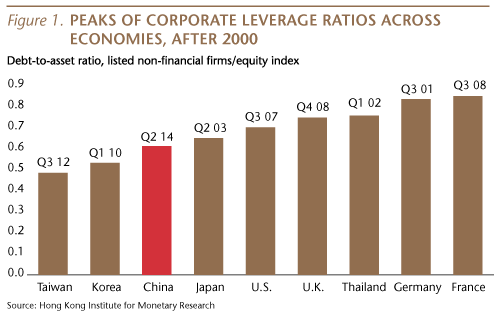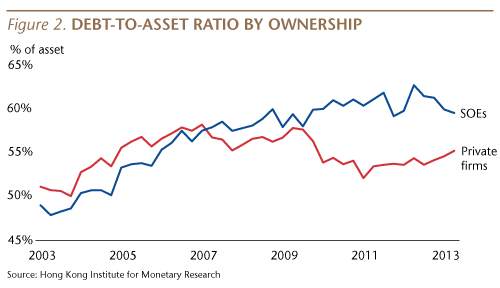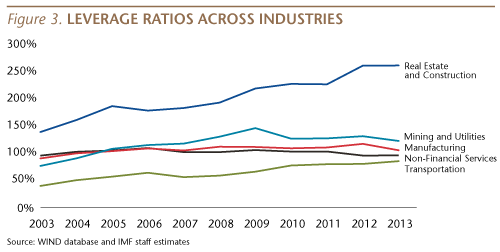Diagnosing China’s Debt Disease
China needs to resolve its debt problems, but unlike the West after the Global Financial Crisis, reforms should actually improve access to capital for the private firms that drive growth in jobs and wealth.
China suffers from a serious case of “debt disease,” but the treatment and side effects may not be as severe as some expect, and dramatic credit tightening is very unlikely. Debt is concentrated among state-owned firms, while the private firms that generate most of China’s new jobs and investment have already deleveraged. The biggest risk is the high level of debt among real estate developers.
Debt is Up Sharply
There is no question that debt levels in China rose sharply after the Global Financial Crisis that began in 2008. A recent study by the McKinsey Global Institute says that from 2007 to 2014, China’s total debt, including debt of the financial sector, nearly quadrupled, rising from US$7.4 trillion to US$28.2 trillion, or from 158% of GDP to 282%.
Another new report, by economists at the Hong Kong Monetary Authority’s think tank (HKMA), notes that this rise in indebtedness “has been partly related to a big stimulus package launched in 2008 to 2009. Unlike the deficit-financed stimulus packages in the West, China’s big stimulus package was funded mainly by bank credit.”
Corporate Responsibility
The main driver of the rise in debt has been borrowing by non-financial corporations, and at 125% of GDP, “China now has one of the highest levels of corporate debt in the world,” according to the McKinsey study.
Despite that, economists at the IMF (International Monetary Fund) report that, “On average, Chinese firms’ leverage is not high.” The HKMA economists agree, noting that “our analysis based on firm-level data indicates that China’s corporate sector does not appear to be over-leveraged in aggregate, despite rapid credit growth following the Global Financial Crisis.”

This doesn’t mean China’s debt disease isn’t severe. But the diagnosis is that the disease is highly concentrated, presenting two distinct hot spots: state-owned enterprises (SOEs) and real estate developers.
State vs. Private
In two new working papers, economists at the IMF and HKMA reach similar conclusions: China’s debt problem is an SOE problem.
“On average, private firms have steadily deleveraged over time while SOEs have increased their leverage,” according to the IMF. The HKMA economists agree: “By ownership, it is mainly SOEs that have increased leverage, while private enterprises have deleveraged in recent years.”
The buildup in SOE debt has been “policy-driven leveraging,” according to the HKMA economists, as the state-controlled banking system “may have been skewed towards SOEs out of policy priority and implicit guarantees by governments. . . It is clear that SOEs would have borrowed less if they had done so on a market-driven basis.”

This is really important for several reasons—first, because privately owned small- and medium-sized enterprises (SMEs) are the engine of China’s economic growth, accounting for more than 80% of employment and almost all new job creation, as well as most investment. With the IMF estimating that median leverage for private firms fell to 55% in 2013 from about 125% in 2006, China’s most important companies are less afflicted by debt disease.
Second, this is important because the banking system is increasingly directing credit away from SOEs and toward entrepreneurs. In 2013, the latest data available, only 29% of loans outstanding were to SOEs, down from 41% in 2006, while the share of loans outstanding to private firms rose to 43% from 36%.
Third, the medicine for this problem will be another round of serious SOE reform—including closing the least efficient, dirtiest and most indebted state firms in sectors such as steel and cement—rather than broad deleveraging, leaving healthier, private SMEs with room to grow. In contrast to the experience in the West after the Global Financial Crisis, cleaning up China’s debt problem should actually improve access to capital for the SMEs that drive growth in jobs and wealth.
IMF economists found that among SOEs, “leverage has increased significantly at the tail end of the distribution at the 75th and 90th percentiles,” meaning that SOE reform can focus initially on a relatively small number of firms.
Real Estate Risks
With McKinsey estimating that about 45% of China’s non-financial sector debt is directly or indirectly related to real estate, the biggest risk to debt disease turning fatal is the residential property sector.
The IMF working paper notes that “across industries, most of the buildup in leverage was in the real estate and construction sector.” But, here too, the problem is highly concentrated, as “only about 60 firms with high-leverage ratios account for more than two-thirds of the sector’s liabilities in 2013, a rise of nearly three times over the decade.”

But the IMF economists are fairly sanguine, reporting that “the real estate and construction sector appears to be able to withstand a 10% decline in profits with the number of firms and the amount of debt at risk increasing only marginally. . . [but] a more severe slowdown (real estate profit declining by 20%) would [result in] . . . significant financial distress.”
Fortunately, we think that although China’s housing market is past its peak and is very soft, a collapse is highly unlikely. Even though the government only removed some barriers to new home purchases (reducing the minimum cash down payment to 40%, from 60 to 70%, for upgraders) at the end of March, the residential market showed signs of stabilizing during that month. New home sales fell only 0.9% year-on-year (YoY) by volume, after declining 17.8% during the first two months of the year. It is also positive that developers have been responding to weaker sales and mounting inventory by cutting housing starts 20% YoY.
And even though the new home market was very weak last year, with sales volume down 9% YoY, after rising by almost 18% in 2013, the top 12 listed developers turned in a decent year, with their sales by volume up 18% and sales by value up 17%. This is one reason why we believe the recent bond default by the privately owned developer Kaisa reflects company-specific problems, rather than the coming collapse of the housing market.
It is important to understand that if, for several months, new home prices are down by, say, 6% YoY, there are a few reasons why this is unlikely to precipitate a crisis. First, because prices rose at an average annual pace of 8.4% over the last nine years, very few homeowners ought to be in the red. Second, new homebuyers, the majority of whom are owner-occupiers, must put down at least 30% cash, far from the 2% median cash down payment made by first-time homebuyers in the U.S. in 2006. Moreover, the products that broke Lehman Brothers—and caused havoc through the U.S. financial system—do not exist in China. There are no subprime mortgages and there are very few mortgage-backed securities. There is no secondary securitization, so no collateralized debt or loan obligations (CDOs and CLOs).
Local Government Debt
A few more points about debt are worth noting, starting with government debt, which is only 55% of GDP, “lower than in many advanced economies,” according to McKinsey. This is important when considering China’s local government debt.
Our long-held view is that China’s banks face little risk of a significant number of local governments failing to repay their loans. We take this view for the following reasons: 1) The loans were made by Communist Party-controlled banks, at the direction of the Party, to Party-controlled local governments to fund construction of Party-approved public infrastructure. 2) There is no independent municipal legal, political or financial structure in China, so all local governments are effectively an arm of the Party and the central government. 3) Every year, in its budget report to the National Peoples’ Congress, the Ministry of Finance states that it will make up local-level budget shortfalls. For 2015, for example, the ministry forecasts that local expenditures will exceed revenue by RMB 500 billion (US$81 billion), with China’s cabinet, the State Council, having “given its approval for this deficit to be made up by the issuance of general bonds by local governments.” 4) Local government debt has increased at a double-digit annual pace for well more than a decade. The absence of any defaults during this period is strong evidence of central government/Party support for these loans, and it is clear that the Party has the capacity to service this debt.
External Debt Low
Finally, China’s foreign debt exposure is low, less than 10% of GDP since 2008. This is a sharp contrast to Thailand’s 62% ratio in 1996, ahead of the Asian Financial Crisis. By funding its infrastructure buildup domestically, rather than through foreign lenders, China has avoided one of the key problems that contributed to past emerging market debt crises.
Andy Rothman
Investment Strategist
Matthews Asia
Sources:
http://www.mckinsey.com/insights/economic_studies/debt_and_not_much_deleveraging/
http://www.hkimr.org/uploads/publication/416/wp-no-10_2015-final-.pdf
https://www.imf.org/external/pubs/ft/wp/2015/wp1572.pdf
